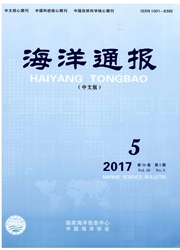

 中文摘要:
中文摘要:
采用浅地层剖面测量、沉积物柱样测年和海图水深计算对比相结合的方法,探讨位于长江入海泥沙向南输送通道上的朱家尖岛海域的泥质沉积速率的历史变化,并通过水文泥沙测量和沉积物取样分析寻找长江入海泥沙向南输送的佐证。结果表明:朱家尖岛海域全新世海平面上升以来泥质沉积厚度为5~20m,相当于沉积速率0.06~0.25cm/yr;1840~1960年区域平均沉积速率为1.4cm/yr,近60年沉积速率仅为此前120年沉积速率的一半左右。据此推断:全新世后期以来该海域泥质沉积速率先后经历了一个长期(千年尺度)缓慢的增大阶段和一个短期(年代尺度)迅速的减小阶段,与长江流域人类活动和河口湾充填作用共同造成的入海泥沙通量的总体变化趋势相吻合。
 英文摘要:
英文摘要:
On the basis of shal ow acoustic surveying, 137Cs dating, and the comparison of bathymetric data, we examined the rates of mud deposition in an area adjacent to Zhujiajian island and inferred the variation in the southwards transport of sediment from the Yangtze Estuary since 8000 yr BP when the study area was submerged by a rising sea level. The mud deposit is 5-20 m thick, equivalent to a rate of deposition of 0.06-0.25 cm/yr since 8000 yr BP. The deposition rate increased to 1.4 cm/yr between 1840 and 1960, after which it decreased by about 40% by 2011. This suggests that the southwards transport of sediment from the Yangtze Estuary to the Zhejiang coast was characterized by a long-duration increasing trend before the 1960s, and by a marked decrease after the 1960s, which is in good overal agreement with the observed temporal variation in sediment discharge from the Yangtze River to the sea.
 同期刊论文项目
同期刊论文项目
 同项目期刊论文
同项目期刊论文
 期刊信息
期刊信息
